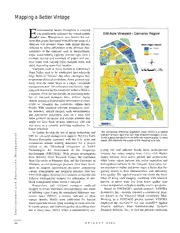
NASA Technical Reports Server (NTRS) 20030099688: Mapping a Better Vintage PDF
Preview NASA Technical Reports Server (NTRS) 20030099688: Mapping a Better Vintage
Mapping a Better Vintage E nvironmental factors throughout a vineyard can significantly influence the overall quality of wine. Winegrowers have known for cen- turies that grapes harvested from different areas of a vineyard will produce wines with unique flavors. Affected by subtle differences in the physical char- acteristics of the vineyard such as microclimate, slope, water-holding capacity, and soil type, even a constant varietal and rootstock of grapes will pro- duce wines with varying color, bouquet, body, and yield, depending upon their location. Vineyards such as those located in California’s Napa Valley tend to be subdivided into relatively large fields or “blocks” that often encompass het- erogeneous physical conditions. Since growers typ- ically treat the entire block as a single “minimum management unit” for cultivation and harvest, map- ping and monitoring the variability within a block is a concern. Over the last decade, an increasing num- ber of vineyard managers have utilized digital remote sensing and geographic information systems (GIS) to visualize the variability within their blocks. With computer software designed to over- lay remotely sensed imagery with environmental and agronomic geographic data on a map, GIS helps growers recognize and explain patterns that might not have been obvious otherwise. GIS can also serve as a valuable archiving mechanism for future reference. To further develop the use of image technology and The normalized difference vegetation index (NDVI) is a relative nt GIS for vineyard management support, NASA’s Earth indicator of plant vigor that can help vineyard managers to sub- divide a grape harvest for more uniformly mature grapes.In many e Science Enterprise partnered with the U.S. wine and m cases, this improves the quality of the resulting wine lots. commercial remote sensing industries for a project e g known as the Viticultural Integration of NASA a Technologies for Assessment of the Grapevine lyzing red and infrared bands from multispectral n a Environment (VINTAGE). With project investigators imagery, has values ranging from -1.0 to +1.0. Higher M from NASA’s Ames Research Center, the California values indicate more active growth and productivity, s State University at Monterey Bay, and the University of while lower values indicate less active vegetation and e Montana, several prototype products have been devel- nonvegetated surfaces. In the vineyard, these index val- c r oped to support agricultural decisions concerning ues translate to higher and lower vigor, a factor that fre- u o canopy management and irrigation practice. One key quently relates to fruit characteristics, and ultimately, s VINTAGE aspect involved the evaluation of satellite and wine quality. The applied research has shown the feasi- e R airborne multispectral imagery for delineation of sub- bility of using such imagery, combined with selective block management zones within a vineyard. harvest, to move wine lots from lower quality (and d n Researchers and vineyard managers analyzed value) designations to highest quality reserve programs. a imagery to divide individual vineyard blocks into zones Based on VINTAGE’s applied research, VESTRA t of differing vigor. Using the normalized difference veg- Resources, Inc., recently released a commercial prod- n e etation index (NDVI), a relative indicator of plant uct known as the Vineyard Block Uniformity Map. m canopy density, blocks were subdivided for harvest Working as a VINTAGE project partner, VESTRA n based upon late-season vigor, resulting in more uniform- employed the ArcView™ 8.2 and ArcGIS™ Spatial o r ly mature grapes, and improved quality of resulting wine Analyst software from Environmental Systems i v lots in many cases. NDVI, which is determined by ana- Research Institute, Inc., to find the percent coefficient n E 44 S P I N O F F 2 0 0 3 of variation (a standard statistical measure) for each are created in consecutive years, a change map can be E block within a 1,000-acre vineyard based on NDVI. The developed to quantify the increase or decrease in unifor- n v result was a vineyard-level map quantifying block vari- mity. They are thus a measurement of success, since i r ability, a helpful tool for crop managers. managers may use the change maps to determine the o VESTRA’s new map product has already been deliv- effectiveness of mitigation practices. The first Vineyard n m ered to several wineries. The maps can serve as an exec- Block Uniformity Maps were produced for the 2002 e utive summary, allowings managers at companies with growing season, and VESTRAanticipates adding change n large and widespread vineyard holdings to easily identi- maps to its 2003 commercial product line. Other proto- t a fy blocks where new or revised management practices type products are under evaluation and may be available n might need to be implemented. Providing a warning, the to growers in the future. d maps can indicate if a block shows variation over a cer- Located in Redding, California, VESTRAis a collab- R tain percent. When the Vineyard Block Uniformity Maps orator on the VINTAGE project along with the Robert e s Mondavi Winery and the nonprofit Bay o Area Shared Information Consortium. All u r project partners have engaged in exten- c sive industry outreach. VESTRA has e s worked closely with vineyards and winer- M ies in prestigious U.S. wine regions such a as California’s Napa Valley and Sonoma n County since 1995. a g e ArcView™and ArcGIS™are trademarks of m Environmental Systems Research Institute, Inc. e n t The Vineyard Block Uniformity Map helps winegrowers solve the problem of monitoring variability within a vineyard block. S P I N O F F 2 0 0 3 45
